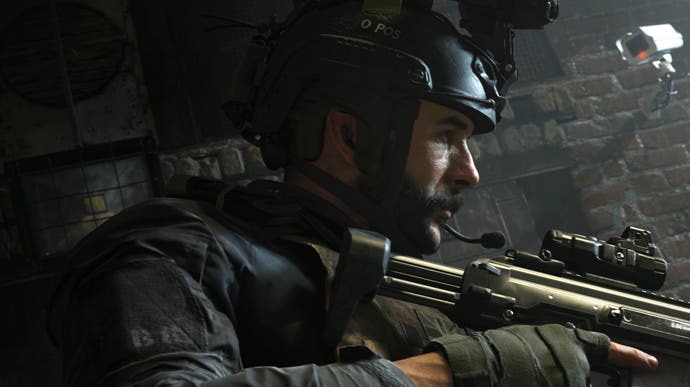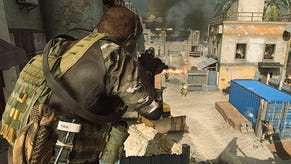Call of Duty: Modern Warfare's engine revamp promises a generational leap in fidelity
Hands on with Infinity Ward's most advanced technology yet.
Call of Duty: Modern Warfare goes official today with a reveal trailer giving us our first glimpse of the look, feel and content of the new game - a COD offering somewhat different to anything we've seen to date. Developer Infinity Ward is targeting a soft reboot of sorts for the Modern Warfare franchise: a Casino Royale-style revamp that transports beloved characters like Captain Price into the battlegrounds of the here and now, whether it's the enduring nightmare of Middle Eastern war zones or eliminating domestic terror cells in central London, it's a big tonal shift for the series - often gritty, harrowing and even shocking in places. From a technological perspective, the trailer demonstrates a radical revamp of COD's rendering technology and the trailer revealed today is running in real-time on PlayStation 4 Pro. No CG fakery, no 'in-engine' footage - what you see is what you get, and it's a new milestone for the franchise.
And obviously, it's the technology that's the focus for Digital Foundry. If you've watched the trailer, you may have noticed a very different aesthetic for this latest entry in the COD series, the result of a massive engine overhaul that reflects a drive to bring a new level of realism and fidelity to the new Modern Warfare. The engine has been radically retooled with an eye for real-life accuracy, kicking off with a move to a state-of-the-art physically-based rendering system built on exploiting photogrammetry - the science of scanning objects directly, replicating not just their shape but material properties such as their roughness and reflectivity, essential for integration into a brand new lighting solution.
Whether we're talking about environment detail - right down to individual stones in a pile of rubble - or the materials used to craft uncanny replicas of the game's weapons (down to customised ceramic finishes), the new Call of Duty engine accommodates this. The objective here isn't just realism, but also consistency - a set level of high fidelity on every element in the game, requiring a big boost to geometry output too. Helped by the integration of an advanced culling algorithm, Modern Warfare is capable of delivering over five times the geometry of prior series entries - making scenes like the crowd shot in the trailer possible. Like all the trailer content, that's running in real-time too, with that scene alone pushing eight million polygons. Procedural boosts to geometry via tessellation on characters, object and environment detail also help to increase the level of detail, with none of the artefacts such as terrain warping at close range that we've seen on some recent titles.
Lighting itself also receives a profound upgrade. Every single light source within the game is volumetric in nature, with the developers able to adjust the density of the atmosphere to the point of including dust motes, simulating humidity or introducing ground-level fog. You may catch crepuscular rays (god rays if you like) but these are not post-process additions, but rather the actual results of accurately rendered volumetric lights beaming through geometry. Differently coloured lights with intersecting paths also blend hues accurately, while the simulation is robust enough that suitable volumetrics even reflect light - similar to engaging full beam headlights in your car while driving through dense fog. Again, it's an example of a rendering feature baked in at the lowest level (you can't disable it on PC) that offers up a lot of gameplay potential.
It's worth taking a closer look at the trailer asset and screenshots to get a sense of how the artistic direction marries up with the technology. In-game skyboxes and lighting levels are sampled from real life locations, photogrammetry is the result of a mixture of on-location capture and in-studio scanning. The post-process pipeline in the mainline COD engine has always delivered excellent results and it's improved again, delivering impressive, consistent results and integrating exceptionally well with the lush volumetric lighting.
Also impressive is the inclusion of what's described as 'spectral rendering' - a system that sees Call of Duty render everything in real-time beyond the visible light spectrum, encompassing infrared and thermal heat radiation. The objective here is very straightforward: lighting is extremely important in Modern Warfare, with levels authored with multiple lighting bakes that blend depending on which light sources are active and which are not. Some lighting conditions make the use of IR goggles essential, with the new system ensuring that night vision rendering is highly realistic, to the point where the light cast by the the goggles themselves is present in the scene (along with the IR reflective markers sewn into uniforms). There are gameplay opportunities here too - switching on lights can temporarily blind those wearing night vision headgear.
The integration of thermal heat radiation mapping also pays off and again, the commitment to realism is impressive. Not only are target and environment temperatures accurately rendered, the game even simulates the low resolution sensors of the various thermal equipment in use throughout, even using a reverse-JPEG algorithm to accurately render compression artefacts.
Infinity Ward also talks about significant new systems that have been built perhaps with more of an eye towards future releases - foremost amongst them what's described as a hybrid tile-based streaming system. Prior Call of Duty campaigns have delivered some extensive maps, but the new addition to the COD engine takes this on to the next level, allocating a grid of 'tiles' around the player's current position, loading and decompressing the data as required, prioritising streaming depending on where the player is looking and the direction they are moving in. It delivers more options to the developers, but also opens the door to much larger multiplayer levels. And of course, this new system gives Infinity Ward the tools to deliver a much larger game world, potentially rich in detail.
One of the key objectives with the latest engine is to help lay the foundation for the future of the Call of Duty series, with initial work starting on the revamp as long as five years ago. Going forward, Infinity Ward's work will be shared across studios such as Sledgehammer and Raven Games, where there has already been a healthy collaborative history. Additionally, with a projected 2020 release date for the next-gen consoles, logically we should see the work seen here transition to the new hardware and evolve further across the years, while also being able to handle cross-gen duties more elegantly than the legacy COD titles that straddled the generations.
Across the years, various Call of Duty titles have sought to push the envelope visually but to a certain extent there has always been a technological tug of war between features and performance. The COD experience is defined by low latency controls and snappy feedback delivered with the help of a 60 frames per second target frame-rate, so where does this leave the new Modern Warfare? Infinity Ward saves its major performance optimisation efforts until the end of development but carries out periodic reviews across development by seeking to optimise single, troublesome frames - the idea being that if a day's work can solve specific hot spots, they should be in good shape when the major optimisation push begins. Meanwhile, nightly builds of the game have automatic performance analysis carried out overnight across all content, creating a historical record of performance on each level that should show gradual improvement over time, while also helping to isolate any updates that may have introduced issues.
I went hands on with the alpha Modern Warfare single-player content seen in the trailer and performance was already at 60 frames per second, even before the optimisation push had begun. Current performance is bolstered by dynamic resolution scaling, variations of which have proven themselves adept at sustaining target frame-rates in prior COD titles including Infinite Warfare and WWII. Infinity Ward's aim is to optimise to the point where DRS is more of a fallback position, with the aim being to deliver the game at as close to target resolution as possible, while still delivering Call of Duty's signature 60Hz update. So, a brand new Modern Warfare with a state-of-the-art engine that retains the series' extraordinary performance level? That's the idea, and if we're at this stage months out from release, the signs are looking very positive for the final code.

















